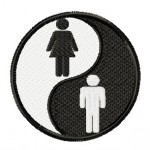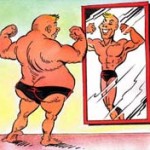Medical Barriers: Testosterone Deficiency
 Today’s post is another excerpt from “Best Weight: A Practical Guide to Office-Based Weight Management“, recently published by the Canadian Obesity Network.
Today’s post is another excerpt from “Best Weight: A Practical Guide to Office-Based Weight Management“, recently published by the Canadian Obesity Network.
This guide is meant for health professionals dealing with obese clients and is NOT a self-management tool or weight-loss program. However, I assume that even general readers may find some of this material of interest.
Testosterone Deficiency
Low levels of total and free testosterone in men may result in increased body fat and decreased lean tissue. Testosterone treatment in hypogonadic men restores lean tissue distribution. Total serum testosterone is inversely correlated with weight. Testosterone and blood concentrations of sex hormone binding globulin (SHBG) progressively decrease in obese men, but free testosterone levels usually remain normal. Massively obese men may have decreased total and free testosterone levels due to an increased adipose-tissue-mediated peripheral conversion of androgens to estrogens.
Aging is accompanied by a gradual decrease in free testosterone levels and increase in body fat. The term andropause has been used to describe symptoms thought to be related to low levels of bioavailable testosterone, including decreased strength and endurance, fatigue, low libido, irritability, and erectile dysfunction.
Testosterone replacement is not currently an accepted or proven adjunct in weight management and its use should be restricted to the symptomatic relief of andropause.
© Copyright 2010 by Dr. Arya M. Sharma and Dr. Yoni Freedhoff. All rights reserved.
The opinions in this book are those of the authors and do not represent those of the Canadian Obesity Network.
Members of the Canadian Obesity Network can download Best Weight for free.
Best Weight is also available at Amazon and Barnes & Nobles (part of the proceeds from all sales go to support the Canadian Obesity Network)
If you have already read Best Weight, please take a few minutes to leave a review on the Amazon or Barnes & Nobles website.
Testosterone Deficiency and What to Do About It
 Male hypogonadism with low testosterone levels can negatively affect muscle mass and has been associated with the increased accumulation of visceral fat. Thus, in clinical practice it may be important to assess older men presenting with weight gain for testosterone deficiency.
Male hypogonadism with low testosterone levels can negatively affect muscle mass and has been associated with the increased accumulation of visceral fat. Thus, in clinical practice it may be important to assess older men presenting with weight gain for testosterone deficiency.
The latest issue of the New England Journal of Medicine features two articles relevant to this issue.
In the first article, Frederick Wu and colleagues (for the EMAS group) surveyed a random population sample of 3369 men between the ages of 40 and 79 years at eight European centers regarding general, sexual, physical, and psychological health. Levels of total testosterone were measured in morning blood samples.
Symptoms of poor morning erection, low sexual desire, erectile dysfunction, inability to perform vigorous activity, depression, and fatigue were significantly (inversely) related to the testosterone level. However, only the three sexual symptoms had a syndromic association with decreased testosterone levels diagnostic of hypogonadism.
Importantly, none of the non-sexual symptoms (decreased energy levels, depression, loss of strength, etc.) were specific enough to screen for or diagnose testosterone deficiency.
The authors conclude that late-onset hypogonadism can be defined by the presence of at least three sexual symptoms associated with a total testosterone level of less than 11 nmol per liter (3.2/mL) and a free testosterone level of less than 220 pmol/L (64 pg/mL).
In the second article, Shehzad Basaria and colleagues from Boston University, examine the efficacy and safety of testosterone supplementation in older men (Testosterone in Older Men with Mobility Limitations (TOM) trial).
A total of 209 Community-dwelling men (mean age, 74 years) with limitations in mobility and low serum testosterone levels were randomly assigned to receive placebo or testosterone gel for 6 months. Not surprisingly, participants had a high prevalence of hypertension, diabetes, hyperlipidemia, and obesity at the time of enrollment into the trial.
Just three years into the study, the data and safety monitoring board recommended that the trial be discontinued because there was a significantly higher rate of adverse cardiovascular events in the testosterone than in the placebo group.
During the course of the study, significantly more men in the testosterone group than in the placebo group had cardiac, respiratory, and dermatologic events.
Of particular concern to the data and safety monitoring board was the greater number of subjects with cardiovascular-related events (23 vs. 5) and atherosclerosis-related events (7 vs. 1).
On a positive note, the testosterone group did have significantly greater improvements in leg-press and chest-press strength and in stair climbing while carrying a load than the placebo group.
While the the study suggests that treating testosterone deficiency in older men with limitations in mobility and a high prevalence of chronic disease is not without risk, the authors raise some important caveats in interpreting this finding.
For one, the overall number of adverse events is rather small and there may have been some limitations with respect to the ascertainment of adverse events. Caution is also warranted in extrapolating these findings to other doses and formulations of testosterone or to other populations, particularly young men who have hypogonadism without cardiovascular disease or limitations in mobility.
I guess further studies will be needed to address the efficacy and safety of testosterone treatment for male hypogonadism. Clinicians will certainly have to carefully assess and discuss the risk/benefit ratio of testosterone substitution treatment with their patients.
AMS
Edmonton, Alberta
p.s. You can now also follow me and post your comments on Facebook
Wu FC, Tajar A, Beynon JM, Pye SR, Silman AJ, Finn JD, O’Neill TW, Bartfai G, Casanueva FF, Forti G, Giwercman A, Han TS, Kula K, Lean ME, Pendleton N, Punab M, Boonen S, Vanderschueren D, Labrie F, Huhtaniemi IT, & the EMAS Group (2010). Identification of Late-Onset Hypogonadism in Middle-Aged and Elderly Men. The New England journal of medicine PMID: 20554979
Basaria S, Coviello AD, Travison TG, Storer TW, Farwell WR, Jette AM, Eder R, Tennstedt S, Ulloor J, Zhang A, Choong K, Lakshman KM, Mazer NA, Miciek R, Krasnoff J, Elmi A, Knapp PE, Brooks B, Appleman E, Aggarwal S, Bhasin G, Hede-Brierley L, Bhatia A, Collins L, Lebrasseur N, Fiore LD, & Bhasin S (2010). Adverse Events Associated with Testosterone Administration. The New England journal of medicine PMID: 20592293
Women Are Fat – Men Are Just Big And Strong?
 Being overweight or obese has been associated with a poor body image and a lower quality of life specially in females, but the impact on males is less clear.
Being overweight or obese has been associated with a poor body image and a lower quality of life specially in females, but the impact on males is less clear.
This relationship was now examined by Saloumi and Plourde from McGill University, Montreal, in a paper just published in Psychology, Health & Medicine.
The analysis was based on data from the nationally representative Canadian Community Health Survey, which included 25,246 males and females aged 15-29 years.
As expected, both satisfaction with their looks and satisfaction with life were inversely associated with excess weight in females.
In contrast, excess weight in older men was associated with greater satisfaction with life (body image in men was not examined).
While older overweight men were less likely to smoke, excess weight was associated with higher rates of smoking, particularly in younger women.
Both men and women with excess weight reported avoiding food because of caloric content and an attempt to control their weight.
Although most males and females with excess weight acknowledged the fact that they were overweight, 20.4, 29.6, and 36.1% of males with excess weight in the age group of 15-19, 20-24, and 25-29, respectively, seemed to think that their weight is “just about right”.
In contrast less than 10% of females with excess weight in all three age groups thought that their weight is “just about right”.
The study points to important differences in how young men and women perceive their excess weight and the strategies that they may adopt to control it.
The authors explain their interesting finding that overweight men appear more satisfied with life than do overweight women with the notion that while men associate excess weight with being “big and strong”, women tend to associate excess weight with being “fat”, something both sexes appear to fear.
Previous researchers have also suggested that while men may avoid high-caloric foods for health reasons, women tend to do so primarily to control their weight.
These differences have important implications both for public health messaging as well as for individual counseling of men and women with excess weight.
I am guessing that distinctly different strategies will be needed to address excess weight in men and women.
I look forward to any ideas my readers may have on how to better convince men that some of that “big and strong” may actually be a significant health risk.
AMS
Edmonton, Alberta
p.s. Join my new Facebook page for more posts and links on obesity prevention and management
Saloumi C, & Plourde H (2010). Differences in psychological correlates of excess weight between adolescents and young adults in Canada. Psychology, health & medicine, 15 (3), 314-25 PMID: 20480435
Guys Don’t Think Size Matters
 In most countries the ratio of obesity between men and women is approximately equal. Yet, the clients in most obesity clinics and weight loss centres are mainly women.
In most countries the ratio of obesity between men and women is approximately equal. Yet, the clients in most obesity clinics and weight loss centres are mainly women.
So what is with the guys?
This question was now examined by Jane deVille-Almond and colleagues from the UK in a paper just published online in the American Journal of Men’s Health.
For this study, 266 male drivers were randomly recruited from motorway service stations and asked about body weight perception and awareness of the relation between adiposity and diabetes as well as weight loss attempts.
The median age of participants was 52 years, and 46% were obese based on BMI and 73% based on waist circumference.
Of participants with normal BMI, 18% thought they were overweight, whereas 26% of overweight participants thought they were “just right” and only 19% of obese participants recognized their obesity.
Based on WC, 30% of participants with normal waist circumference thought they were obese and 9% of obese participants realized they were obese.
Only 25% and 42% of participants recognized that diabetes is associated with large waistlies and obesity, respectively.
A total of 81% of overweight and 62% of obese participants (based on BMI) believed that they were not at increased risk of diabetes.
Perhaps not surprisingly, self-perception of adiposity in men was only a weak predictor weight loss attempts.
I guess a lot more has to be done to bring obesity awareness to menfolk’s attention – especially given that their risk for metabolic complications and early infarcts associated with excess weight is as high if not higher than that of women.
AMS
Edmonoton, Alberta
p.s. check out my new Page on Facebook
Deville-Almond J, Tahrani AA, Grant J, Gray M, Thomas GN, & Taheri S (2010). Awareness of Obesity and Diabetes: A Survey of a Subset of British Male Drivers. American journal of men’s health PMID: 20413385


